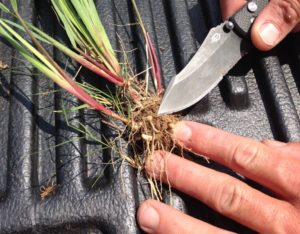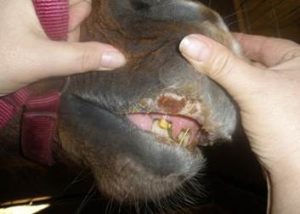
 This is an update to a post run several years ago. You can also download a print-friendly PDF version of this article here, Knotroot Foxtail Facet L Fact Sheet-Revised.
This is an update to a post run several years ago. You can also download a print-friendly PDF version of this article here, Knotroot Foxtail Facet L Fact Sheet-Revised.
Knotroot Foxtail
Knotroot foxtail is a warm-season perennial grass that is also known as knotroot bristlegrass or simply perennial foxtail. It is native to the Americas and can be found throughout Tennessee in hay fields, pastures, lawns, roadsides and waste sites.
Knotroot foxtail is difficult to control. Some of the most serious knotroot foxtail problems are in bermudagrass hay fields. The rough texture of foxtail seedheads in hay can cause ulcers around the mouths of horses. Most other foxtails are annuals and are less difficult to control in bermudagrass. However, the perennial nature of knotroot foxtail makes it a greater challenge. Plants can send up more shoots from the rhizomes even after herbicide application.
Recommendations
UT Extension recommends applying Pastora at 1-1.5 ounces per acre plus glyphosate at 8 oz per acre (of a 4lb per gallon product) for knotroot foxtail suppression. For heavily infested fields, a second application of Pastora at 1 ounce per acre can be made 10 to 14 days after the first application. Applications of Pastora or Pastora plus glyphosate at these rates will cause noticeable stunting and discoloration of bermudagrass, but it will recover. Keep in mind that no more than 2.5 ounces per acre of Pastora can be applied to a bermudagrass field per year.
Hay producers have experienced a lost cutting of hay due to the stress on the forage from the Pastora/glyphosate application. This issue led to several years of on farm research conducted with different combinations of fertilizers, herbicides, adjuvants, and application timings to find another option for suppressing knotroot foxtail in bermudagrass hayfields. Replicated, randomized blocks of treatments were conducted and evaluated over the course of several growing seasons. The most promising treatment that showed suppression of the foxtail with the least damage to bermudagrass was Facet L. Here’s what you need to know.
Facet L
Facet L should be applied early postemergence to small, actively growing weeds and grasses for optimum control. Allow 7 days after application prior to cutting for hay (may graze immediately) so Facet L may translocate through plants effectively to provide control.
Facet L is labeled for most warm-season and cool- season established grasses grown for pasture and hay. The cool-season grasses that Facet L is labeled on are meadow bromegraass, smooth bromegrass, smooth x meadow bromegrass, European dunegrass, fine fescue and tall fescue, Junegrass, Kentucky bluegrass, needle and thread, green needlegrass, orchardgrass, annual ryegrass, Indian ryegrass, perennial ryegrass, bluebunch wheatgrass, bluebunch wheatgrass X quack cross, crested wheatgrass, fairway wheatgrass, fairway X crested wheatgrass, intermediate wheatgrass, pubescent wheatgrass, Siberian wheatgrass, slender wheatgrass, tall wheatgrass, thickspike wheatgrass, Western wheatgrass, Altai wildrye, basin wildrye, beardless wildrye, Dahurian wildrye, mammoth wildrye, and Russian wildrye. The warm season grasses that Facet L is labeled include bermudagrass, big bluestem, little bluestem, sand bluestem, buffalograss, Eastern gammagrass, blue gramma, side-oats gramma, Indiangrass, lovegrass, prairie sandreed, and switchgrass.
Application
Facet L has an application rate range of 22 – 32 fl. oz./acre. However, 32 fl. oz. is the primary use rate necessary for consistent performance on tougher to control labeled broadleaf weeds and grasses. Sequential applications may be used, but no more than 64 fl. oz./acre may applied per year.
Facet L is only labeled for established grass pastures and is very safe on forage grasses in which it is labeled. There is 0 days grazing and a 7 day haying restriction regardless of rate on Facet L. The reason for this restriction is due to weed control since Facet L is a systemic herbicide which needs to translocate through the weeds to provide complete control.
Adjuvants
It is recommended to add 2 pints/acre of methylated seed oil (MSO) to Facet L for better uptake and enhanced weed control. A nitrogen fertilizer source such as ammonium sulfate (AMS) or urea ammonium nitrate (UAN) can be added for better uptake and enhanced weed control. Facet L may be tank-mixed with other herbicides labeled for use in pasture unless prohibited by the other herbicide label. The most restrictive label applies to tank mixes ie. adjuvant selection. For instance, when Facet L is tank mixed with other herbicides that restrict the use of oil additives, an 80% active nonionic spray surfactant (NIS) at 1 quart per 100 gallons and a nitrogen fertilizer source (AMS or UAN) must be used. However, this may limit the expected performance. Good moisture conditions and actively growing weeds is particularly necessary for Facet L to achieve the best weed control.
Weeds Controlled
Research has shown that Facet L controls annual grass weeds postemergence (POST) including barnyardgrass, junglerice, large crabgrass, broadleaf signalgrass, annual foxtails (green, giant, yellow). Knotroot foxtail (Setaria parviflora) is a perennial, warm season grass. Currently, the most recommended herbicide treatments only provide suppression, not complete control and pastures show noticeable stunting and discoloration, particularly with bermudagrass. Facet L, however, has exhibited significant promise for Knotroot foxtail management in trials over the last several years. Additionally, virtually no pasture response has been observed. The broadleaf weeds that Facet L controls include clovers, prickly lettuce, morning glory species, hemp sesbania and suppresses common and giant ragweed, Russian thistle, dandelion, sowthistle, and Canada thistle. For best results broadleaf weeds and grasses should be 2 inches or less in height at the time of application.
Facet L provides residual control and can be applied PRE before weeds emerge. However, POST applications to weeds are more effective and consistent.
Take Home
- Facet L herbicide shows good promise for management of Knotroot Foxtail in bermudagrass hay.
- Facet L herbicide shows little to no forage response when applied at either rate or timing.
- Prowl H2O in combination with Facet L enhanced the system by providing residual control of southern crabgrass, barnyardgrass, goosegrass, S. Johnsongrass.
- Be sure to ALWAYS follow the label for any herbicides you use. For any questions or comments call your local extension office.

